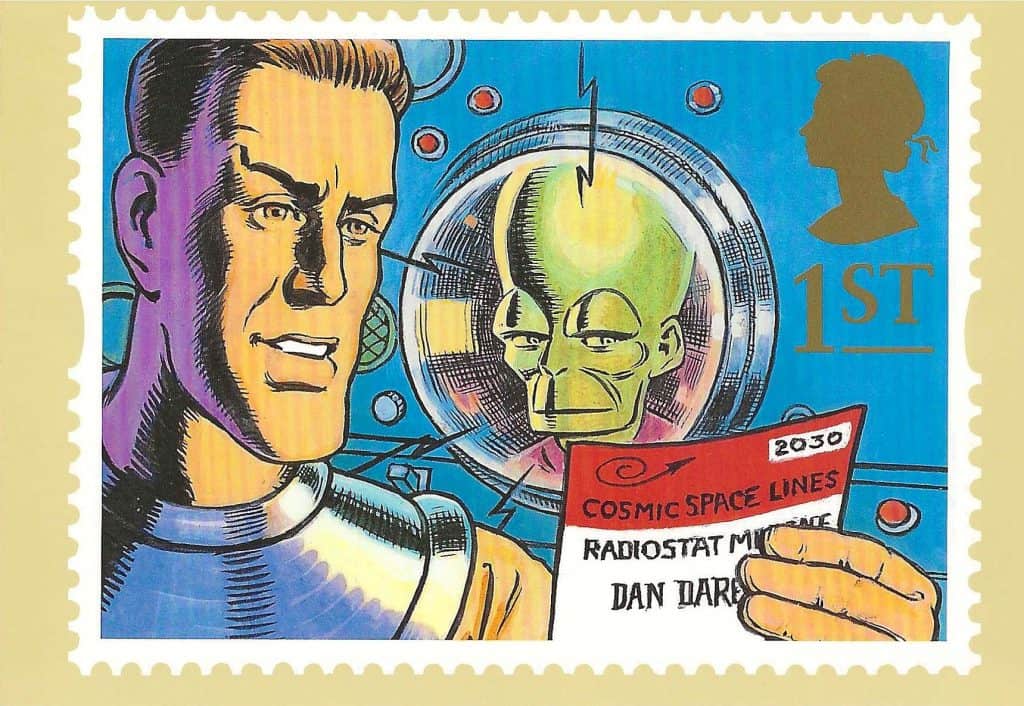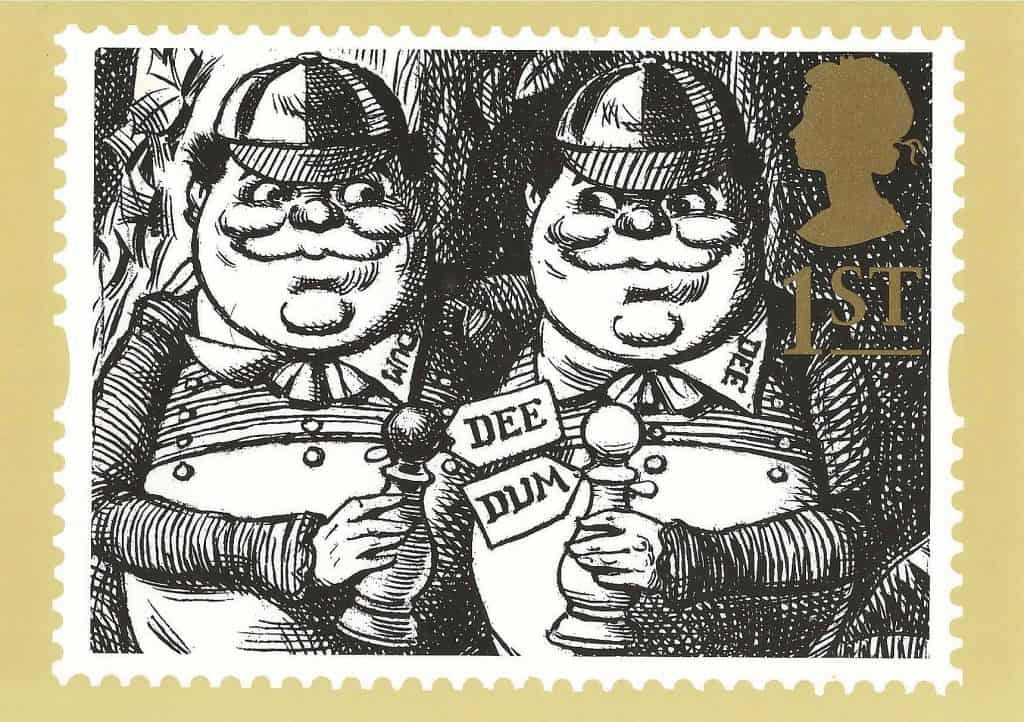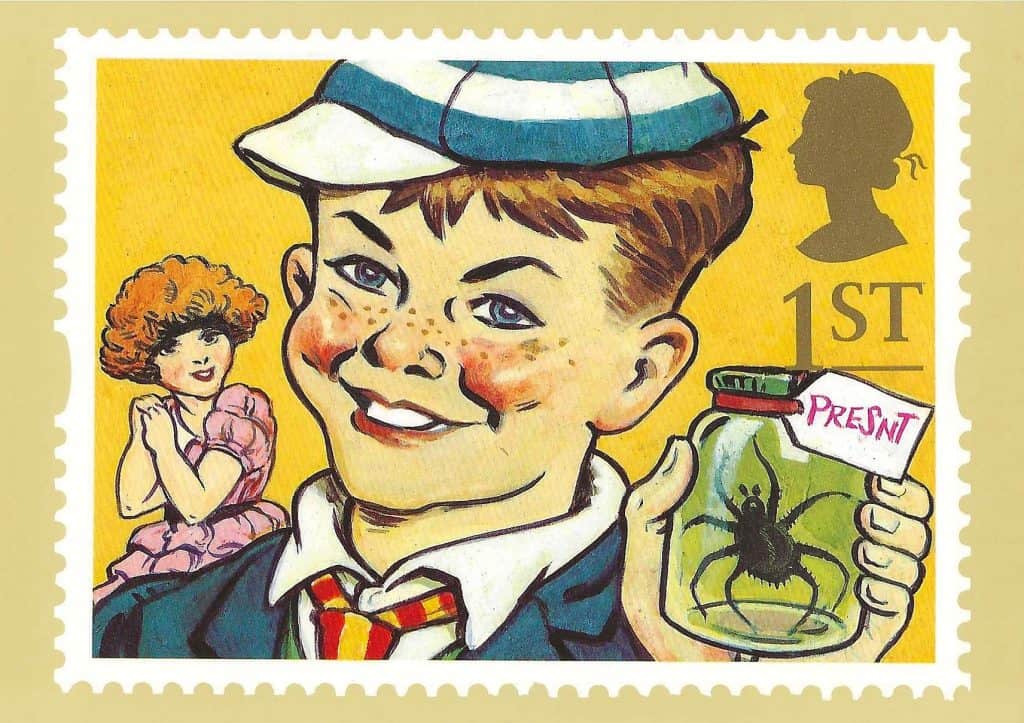Just in case you’re unaware, one of the world’s most successful producers of modern postcards is the United Kingdom’s Royal Mail. What we know is that postcards were introduced to Britain in 1870. They were produced in two sizes and followed on the Hungarian design. Commissioned by the British Post Office, the cards included an imprinted halfpenny stamp that covered the price of postage and was half that of a letter.
We may need to rely on our British cousins for details such as how many sets of cards have been made available through the years, but from personal experience, since 1987, they do from four to six sets each year. The Christmastime set is always the bestselling.
The newest set in the office at Postcard History is from 1994. It is entitled Send a Little Happiness with Royal Mail. It is a 12-card set featuring British cartoon and comic characters that span the entire twentieth century.
The collection is presented to our readers with smiles on our faces.
***
Aladdin

The story of Aladdin comes from the ancient Syrian storyteller Hanna Diyab. It is the general belief among folklorists that it was with Diyab that the best-known versions of Aladdin and Ali Baba and the Forty Thieves cane to be known and were later added to the One Thousand and One Nights archives by the French orientalist Antoine Galland.
Big Friendly Giant

Best known as BFG, the Big Friendly Giant is the title of a child’s novel by Roahl Dahl. It is an elaborate version of a short story he wrote in 1975 entitle Danny, the Champion of the World. The book is dedicated to Dahl’s oldest daughter, Olivia, who died of measles encephalitis in 1962.
The story is about Sophie, an eight-year-old girl who lives in an orphanage. Sophie cannot sleep. She spends most of bedtime looking out of her window. One night she sees a mysterious giant man in the street, carrying a suitcase and a trumpet. The giant sees Sophie, who tries to hide, but the giant reaches through a window, picks her up, and carries her to a large cave in the middle of a faraway land. Believing that he intends to eat her, Sophie pleads for her life, but the giant laughs and tells her to forget her outlandish ideas. He explains that although most giants do eat humans, he does not because he is the Big Friendly Giant, or BFG; he had carried Sophie off merely so she would not reveal that she had seen a real giant, which would put him at risk of being captured for a zoo-exhibit.
The story of the BFG has a delightful, but not quite believable ending.
Dan Dare

Dan Dare is a British science fiction comic book hero, created by Frank Hampton. Hampton was also the author of the original stories. His character, Dare, appeared in a comic series Dan Dare, Pilot of the Future from 1950 to 1967. The stories were set in the late 1990s, but the dialogue and mannerisms of the characters were reminiscent of war movies made in the 1950s.
Dan Dare is often described as the British equivalent of Buck Rogers. The Dan Dare character is identified by his long, complex storylines and snappy dialogue. The artwork was also remarkable. Each panel was meticulously illustrated by Hampson and his crew of artists, including Harold Johns and Don Harley.
Dee and Dum

Tweedledum and Tweedledee are characters in Lewis Carroll’s 1871 book Through the Looking-Glass, and What Alice Found There. Their names may have originally come from a ditty written by the poet John Byrom. The names have since become synonymous in western pop-culture slang for any two people whose appearances and actions are identical.
Just William

William Brown is a character created by Richard Crompton as a central figure in a series of children’s short stories written in 1922. The Just William stories first appeared in Home magazine. The tales were so popular that they were soon made into books and the books became the basis for numerous television series under the title: The William Brown Stories.
William was an impish boy who loved tormenting others, especially girls of his age. The artist of the stamp made for this Royal Mail series is uncredited but they have captured the essence of William perfectly. He is about to present a shy young girl was a huge black spider in a glass jar.
Some of the Just William story titles are as fascinating as the stories themselves: for example, in “William Goes to the Pictures” – William’s aunt gives him a shilling, so he buys sweets and goes to the cinema. On his way home he is obsessed with acting out what he has seen. In “William the Intruder” – William steals the attentions of his brother’s new crush.
In “The Fall of the Idol” – William has a crush on his teacher Miss Drew, but eventually discovers she has feet of clay. In “A Question of Grammar” – William’s willful misunderstanding of a double-negative leads him to throw a wild party in his parents’ absence. In “William and White Satin” – When William is forced to be a page at his cousin’s wedding, he becomes a figure of ridicule. However, he soon finds an ally in an equally reluctant bridesmaid, his cousin.
And the adventures of William continue.
Noggin and the Ice Dragon

Noggin the Nog is a fictional character who appeared in a BBC Television animated series of the same name, that was originally broadcast from 1959 to 1965, and in a series of illustrated books that were published between 1965 and 1977. Oliver Postgate and Peter Firmin created both. Noggin himself is the simple, kind and unassuming “King of the Northmen” in what may be considered a Viking Age setting, with various fantastic elements such as dragons, flying machines, and talking birds.
The Ice Dragon appears in a few of the later stories. His name is Grolliffe and he is a friendly ice dragon. He befriends Noggin and helps him in his quest to find a queen who will help him rule the kingdom of the Nogs. Noggin must be successful, or he must forfeit the crown to Nogbad, his uncle. Grolliffe is a handsome ice dragon; he looks much like a frozen cucumber with bright yellow eyes and a nose the shape of a stunted carrot.
Orlando

Orlando is a big Marmalade cat who knows how to read and write. He is learned and scholarly, and has a wife named Grace and three kittens named Pansy, Blanche, and Tinkle. Orlando is a scholarly feline and has many accomplishments yet seen in most cats: he has been a doctor, a judge and a farmer. Orlando has also made trips Abroad and to the Moon.
The series was created by Kathleen Hale, who attended school in London in the 1920s, but after marriage moved to a Hertfordshire farm where they raised two sons and kept several animals – including cats.
Orlando was a favorite of Hale’s elder son Peregrine, who was devoted to him, and that is how the Marmalade cat came to be the central character in the stories that were written to entertain the young boys at bedtime.
Paddington

Paddington, along with Smokey, Teddy, Yogi, and Winnie-the-Pooh are bears recognized around the world. However, Paddington is the only bear whose story has been translated into 30 different languages and his books have sold more than 32 million copies.
He is a fictional character in children’s literature who first appeared in October 1958, in the book A Bear Called Paddington by British author Michael Bond. He is also featured in twenty-nine other books written by Bond, the last of which, Paddington at St. Paul’s, was published posthumously in 2018.
Paddington is a well-travelled fellow and he goes everywhere with a warning pinned to his collar that reads, “Please look after this Bear. Thank you!”
Actually, Paddington was chosen in 1994 by the British Transportation Authority to be the first passenger on the new Chunnel Train to the French countryside. He had a audience with Queen Elizabeth II in 2022, and to this very day there is a statue of Paddington awaiting passersby at the London tube’s Paddington station on the Bakerloo, Circle, Hammersmith, City, and District lines.
It is one of those places that if you stand there long enough, you can watch the world walk by.
Peter Rabbit and Mrs. Peter Rabbit
Peter Rabbit is a fictional rabbit in various children’s stories by English author Beatrix Potter. He is a mischievous, adventurous young rabbit who wears a blue jacket. He first appeared in The Tale of Peter Rabbit in 1902, and subsequently in five more books between 1904 and 1912. The six books by Potter featuring Peter Rabbit have sold millions of copies around the world. In addition, spin-off merchandise has included many things from dishes to wallpaper. In 1903, Peter Rabbit was the first fictional character made into a patented stuffed toy.
Peter and Mrs. Rabbit are totally anthropomorphic. They wear human clothes and do human things like mailing letters and go shopping on rainy days.
Potter created The Tale of Peter Rabbit nearly a decade earlier, in 1893, by sending a letter to Noel Moore, a five-year-old son of Potter’s former governess, Annie Moore. The boy was ill, and Potter wrote him a picture and story letter to help him pass the time. The letter included sketches illustrating the narrative.
In June 1903, the Frederick Warner Company published a trade edition of the tale and by the end of the year, 28,000 copies were in print. Over the years, the original version of Peter Rabbit has sold more than 40 million copies.
Snowman

The Snowman is a wordless children’s picture book by British author Raymond Briggs. It was first published in 1978 by Hamish Hamilton in the UK and by Random House in the United States in November of the same year. The book won several awards and was adapted into a television film in 1982. It has since become an annual Christmas fixture.
The book is entirely wordless and is illustrated with colored pencil drawings. The drawings are totally convincing in telling the story about how a young boy who builds a snowman in his garden, then wakes up the next morning to find his snowman has come to life. The boy shows the snowman his home, and the snowman takes him on a magical journey.
The Wind in the Willows

The wind blows through the willows like a zephyr from the heavens.
The Wind in the Willows is a classic children’s novel by the British novelist Kenneth Grahame, first published in 1908. It details the story of Mole, Ratty, and Badger as they try to help Mr. Toad, after he becomes obsessed with motorcars and gets into trouble.
The novel was based on bedtime stories Grahame told his son Alastair. It has been adapted numerous times for both stage and screen.


Nice article, thanks
For many years I was a collector of these PHQ cards (postal Headquarters, if I remember correctly) and UK postage stamps. I fell into the trap of collecting mint stamps, FDCs, Presentation Packs, and booklets and would also buy mint PHQ cards and a set with postmarked matching stamps on the face. British stamps and these cards are usually little works of art and the Post Office moved from about 6 sets a year to almost one per month. There were frequently 10 to 12 stamps / cards per set…although sometimes more. In addition, the stamp issues changed from notable… Read more »
Ownership of such things can always be a distraction. Access to the information, or the items often fills the bill without contributing to a “consumerist” mentality. In the United States folks have been burned by collecting items hoping they prove an investment. Beanie Babies were a huge scam, but so have collectable plates, Christmas ornaments and baseball cards among other things. Bottom line is collect for enjoyment, stay within your budget and share the joy of your collection with others!
As an American, I was not familiar with many of these characters, although I’ve known about Aladdin and Peter Rabbit, among others, since I was a child.
Thankyou My whole life represented in these stamps and the charming stories
And I have a grand daughter into dragons
sadly we have almost killed the wonderful hobby of stamp collecting
There are still lovely stamps around the world, but yes, the concept of revenue producing stamps for collectors has to me created an artificial feel to the experience. Still, as witnessed on this wonderful site, people have passion and share it and for me, I’m grateful to touch the hem of these collectors.
I recognize all of the stories on these delightful postcards although I am not a Just William fan. I prefer Jennings. Probably few Americans have read either of them.